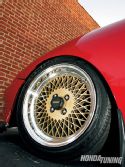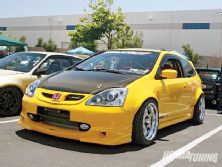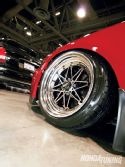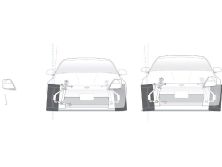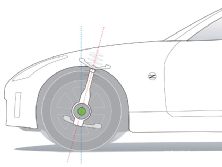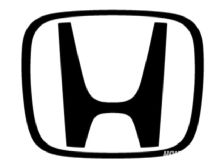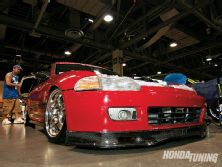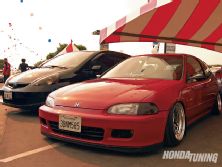Know Your Roots
Car customization has always been about form versus function. But the import industry's roots were established in street racing and, in the beginning, all that mattered was dominating the quarter mile-whether it was on the track or on the back streets of SoCal, function ruled and everything else was lame. Aesthetic issues like how a well a particular wheel and tire fit inside its fender were considered afterthoughts. But the market's evolved and all sorts of trends have come and gone; some of them have stood the test of time. The trend as of late? Aggressive wheel offsets. Low, burly, near-zero offsets-offsets you'd never expect to find on a FWD car-offsets paired with massive amounts of negative camber just to get them to work. It's been the rage for some time, but do you know the history behind it? Do you know where it all came from? It wasn't invented yesterday.
Offset Defined...Again
The subject is hot, and getting the right wheel to fit is just as much a science as it is an art. To review, offset is the distance from the wheel's hub mounting surface to its centerline. It's typically measured in millimeters and directly affects where a wheel sits in relation to its fender. Simply put, lower offsets push the wheels away from the car, positive ones in. A zero-offset wheel means that its mounting surface is even with its centerline. Most wheels designed to be used with Hondas have positive offsets, meaning their mounting surfaces are closer to the outside of the wheel, resulting in a wheel with a face that sits inside the fender line. Manufacturers set recommended offsets to prevent inner fender rubbing as well as fender lip and suspension interference. But nobody follows what the manufacturers suggest.
Low And Slow
Southern Californian lowriders were the first to run low-offset wheels. Sure, a few of those lowriders were Hondas, but this was no Honda trend. Their wire wheel of choice, Daytons, rose in popularity during the early '80s, and their low -offset 13- and 14-inch rims made use of large backspacing to get the look they wanted. But it was all about rolling low and slow and, to be sure, performance really wasn't the motivating factor here as scrub radiuses and steering characteristics were severely affected. Their wheels were small and skinny, not necessarily synonymous with the low-offset look we've become accustomed to but, nevertheless, this is where it started.
Trucks: Big And Small
Mini-trucks entered the picture next but went an entirely different route. The look revolved around high offsets in an effort to tuck the wheel as far underneath as possible. Long before 20-inch rims were available, mini-truck enthusiasts were stuffing 18-inches of metal under all four corners thanks to the help of creative offsets. Again, there was no real performance gain here, but aesthetics once again reigned supreme.
And then there was the off-road guys.
Off-road trucks have long used low-offset wheels to stuff huge tires under their beds. During the late '90s, as enthusiasm for mini-trucks faded, the Trophy Truck style boomed. Many enthusiasts stuffed low-offset wheels in place in an effort to widen the truck's track, in turn evening out the load over the tires. But since most of these trucks used lifted, long-travel suspensions, fender rubbing never became an issue. As for the off-road boys, performance was the motivator when it came to wheel offset, even if most of them never did see the dirt.
Thanks, Drifting
Lowriders and trucks aside, and unbeknownst to most of the low-offset Honda faithful, the original drifters are really the ones to be credited for this trend, but not in the way that you think. Japanese drifters have been searching for ways to fit wheels with the widest lips possible for more than a decade. Unfortunately for those who make their livings sliding around corners though, running a wide rim meant having to run a wide tire. The result meant excessive grip, which wasn't all that conducive when considering the whole point of drifting revolves around a controlled loss of traction. Negative camber was their answer. The inward tilt didn't just mean these guys could stuff the wide-lip rims into place that they needed, it also meant they could now sacrifice a bit of traction thanks to the reduced contact patch. Call it a band-aid, call it half-assed, but don't call it an engineered solution. This, combined with excessively stretched tires, meant less rubber would hit the road, making, say, a 9.5-inch rim and tire combo a lot easier to slip and spin. The pros eventually realized that all of this resulted in a nasty side effect: understeer. As such, hardcore drifters who had little trouble producing the power to light things up turned away from the trend and the lesser teams who still struggled in the hp-making department continued to rely on the band aid. Despite all of this, it ultimately caught on in the U.S., as many enthusiasts who thumbed through the Japanese car magazines but couldn't read the captions where some of these guys were being clowned began thinking it was simply the "JDM thing to do." Originally intended for make-shift performance for the guys who had trouble making enough power, it's somehow ended up as the cool thing to do and, make no mistake about it, few enthusiasts will deny its good looks-it's just funny where it all stemmed from.
Low-offset Honda setups have taken the forefront for some time now and, since the term "hella flush" has been coined, many have jumped on the bandwagon. Choosing the proper offset can improve important things like roll characteristics and handling. But, like everything, it's all about moderation. Similar to monkey bar rollcages that are often more dangerous than no cage at all and Altezza tail lights that, well, just look dumb, the performance gains realized from demon camber setups and stretched tires are minimal, that is, unless you've got an underpowered drift machine that's having trouble getting loose around the corners.

